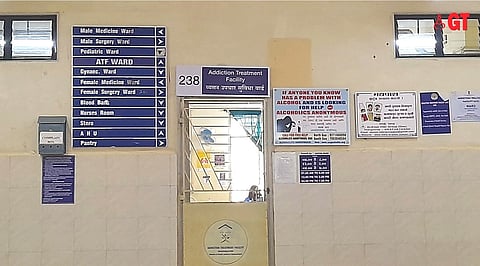

Drugs came to Goa along with tourism, and with the government emphasis on boosting the industry, drugs and alcohol are now the primary lure for tourists. Unfortunately, the menace has insidiously crept into Goan society to the point of grave concern.
Fortunately, though late, the government is slowly putting a remedial system in place.
“No college is a safe place,” confesses Dr Priyanka Sahasrabhojanee, Medical Officer of Addiction Treatment Facility (ATF) at the North Goa District Hospital while stressing on the alarming increase in heroin addiction and how government hospitals are trying to cope with the problem.
“We have had patients tell us how they were introduced to drugs by peers in school. The rate of drug abuse is going up in Goa because of the easy availability of drugs,” states Dr Sahasrabhojanee.
“There was a day when I was walking on the beach, and I was stopped and asked by someone I did not know whether I wanted drugs,” said Dr Sahasrabhojanee.
The ATF centre set up at the North Goa District Hospital sees a number of recovering heroin addicts coming for their daily dose of methadone syrup or buprenorphine tablet.
Men and women chat, wait in line for their daily dose, and after supervised consumption leave the centre to return the next day. Not all seem like they have completely recovered, but that they are off the heroin is a worthy enough accomplishment.
“After recovering from the addiction to heroin, patients attend directly observed treatment where they are administered drugs in the presence of the staff, as many a time these same drugs can be smuggled out to be sold,” explains Dr Sahasrabhojanee.
“People get addicted to methadone and buprenorphine too, but they are less harmful,” acknowledges Dr Sahasrabhojanee.
“To kill a bigger devil, we give them a dose of a smaller amount of a known substance,” reasons Dr Sahasrabhojanee, as she admits that medical treatment is just one aspect of drug rehabilitation.
“We need a multidisciplinary approach to cure drug addiction, and that is why the government now believes that departments of social justice, education and even sports should be part of the programme,” she confesses.
Dr Sahasrabhojanee thinks there are just over five thousand psychiatrists in India. It is too small a number for a country with the population of India. “Drug addiction has to be fought by all and not just a few,” she believes.
The ATF centre in Mapusa sees addicts from Goa, India and foreign countries. “We have addicts from Nepal, Bangladesh, Russia, Britain and even Germany. And, from these, a big number are from Nepal and Bangladesh,” discloses Dr Sahasrabhojanee.
“Addicts do not disclose from where they procure the drugs, but during interactions, confess that most of the drugs come from outside,” confides Dr Sahasrabhojanee.
“We normally have around ten drug addicts coming on a daily basis to the OPD and around twenty-five to thirty admissions every month. We have between sixty to sixty-five registered patients,” is the drug storyline of North Goa as told by Dr Sahasrabhojanee. Forty patients come for directly observed treatment every.
“Drugs are a big basket that has everything in it from hashish to the worst chemicals. Getting people who have fallen into the basket out is difficult but a rewarding task. Hearing people thank you for getting them back on track is a reward that words cannot convey,” says Dr Sahasrabhojanee.
“Start with yourself. Each parent should be his or her child’s first role model,” and it is only then, according to Dr Sahasrabhojanee, that the sequence of nature, nurture and culture makes sense.